Gladys L. Y. Cheing, PhD and Winnie W. Y. Chan, MSc
From the Department of Rehabilitation Sciences, The Hong Kong Polytechnic University, Hung Hom, Hong Kong
Gladys L. Y. Cheing, PhD and Winnie W. Y. Chan, MSc
From the Department of Rehabilitation Sciences, The Hong Kong Polytechnic University, Hung Hom, Hong Kong
OBJECTIVE: To investigate whether the choice of electrode placement site in transcutaneous electrical nerve stimulation (TENS) over acupuncture points vs peripheral nerve points influences the peripheral neurophysiological effects as reflected in negative peak latency in the superficial radial nerve, and on sensory changes in terms of peripheral mechanical pain threshold and mechanical pain tolerance in humans.
DESIGN: Randomized controlled trial.
SUBJECTS: Forty-five healthy subjects by convenience sampling.
METHODS: Subjects were randomly assigned to receive: (i) TENS with electrode placement on acupuncture points; (ii) TENS on non-acupuncture points along the same peripheral nerve; or (iii) no stimulation as the control. In the TENS groups, electrical stimulation was delivered at a frequency of 4 Hz and pulse duration of 200 μs for 30 min.
RESULTS: Significant increases in negative peak latency and mechanical pain threshold over time (p = 0.015, 0.002) were found within the 2 active TENS groups. However, there was no significant difference between the 3 groups in all outcome measures at any of the measurement points (all p = 0.05).
CONCLUSION: TENS over acupuncture points offers no additional hypoalgesic effects vs TENS over peripheral nerve points in a specific anatomical region.
Key words: TENS, acupuncture point, mechanical pain, nerve conduction.
J Rehabil Med 2009; 41: 412–417
Correspondence address: Gladys Cheing, Associate Professor, Department of Rehabilitation Sciences, The Hong Kong Polytechnic University, Hung Hom, Kowloon, Hong Kong. E-mail: gladys.cheing@inet.polyu.edu.hk
Submitted July 25, 2008; accepted December 16, 2008
INTRODUCTION
Transcutaneous electrical nerve stimulation (TENS) is a pain modulation electrical modality that has been adopted for decades. Clinical studies have reported that those with both acute and chronic pain conditions respond favourably to TENS (1, 2). In order to achieve the maximum hypoalgesic effect, stimulation parameters including pulse frequency, pulse width, amplitude, duration of stimulation, and electrode placement have to be manipulated. As TENS can be prescribed for various pain conditions, a wide range of stimulation variables could be considered, but there is little consensus on the optimal stimulation variables (3).
Walsh and colleagues (4, 5) showed that TENS delivered at a frequency of 110 Hz and pulse width of 200 μs could mediate hypoalgesia by increasing both peripheral nerve conduction latency and mechanical pain threshold. Wolf and co-workers (6) studied the issue of TENS electrode placement, but found no clear correlation between optimal electrode placement and pain relief.
In clinical practice, the TENS electrodes are commonly placed at 4 broad categories of anatomical sites, including over the painful areas, along the peripheral nerves, along spinal nerve roots, or other specific points. A number of studies have also demonstrated considerable effectiveness in applying TENS over acupuncture points (1). Two sham-controlled studies demonstrated that the stimulation from TENS over acupuncture points using an alternating frequency of 2 Hz and 100 Hz was more effective than that from non-acupuncture points for post-operative analgesic requirement (7, 8). Patients required less post-operative opioid analgesic and, hence, experienced a decrease in related side-effects and a reduction in pain scores. These results implied that the manipulation of stimulation sites in TENS was crucial.
Both clinical and experimental studies have been carried out to investigate the effects of TENS application over acupuncture points. It was reported that electroacupucture delivered at both 2 and 100 Hz is effective in the management of acute gouty pain in humans (9) and ankle sprain in rats (10); but the low frequency of 2 Hz showed better results in both studies. The application of TENS at specific acupuncture points could be a non-invasive adjunct for pain relief in the first stage of labour (11). Nevertheless, no peripheral neurophysiological changes relating to TENS over acupuncture points were assessed in these studies.
Chesterton and co-workers (3) demonstrated that TENS stimulation delivered at a frequency of 4 Hz and pulse duration of 200 μs with high intensity over acupuncture point could achieve rapid hypoalgesia by measuring mechanical pain threshold. However, no information on neural activity and changes in peripheral neurophysiological aspects was recorded. Meanwhile, Yuan et al. (12) demonstrated that the application of TENS at 4 Hz over acupuncture points could produce analgesia in cold-pressor-induced pain.
Even though some studies favoured electrical stimulation over acupuncture points in pain modulation (3, 7), no previous study has compared the effectiveness of TENS over acupuncture points vs non-acupuncture points on peripheral neurophysiological and sensory changes. Therefore, the present study aimed to investigate whether the choice of electrode placement sites of TENS would influence subsequent peripheral neurophysiological and sensory changes in young healthy subjects. Outcome measures included the change in negative peak latency (NPL) recorded from superficial radial nerves (SRN) sensory nerve action potential (SNAP), and the changes in mechanical pain threshold (MPT), and mechanical pain tolerance (MPTol). These responses could provide some information on the peripheral neurophysiological changes for TENS with different electrode placement, which may increase treatment efficacy in managing clinical pain conditions.
METHODS
Subjects
Forty-five young healthy volunteers (21 men, 24 women; mean age 28.4 years; age range 18–48 years) who were free from any pain conditions were recruited by convenience sampling. Subjects were excluded if they were pregnant, receiving pain medication, had experienced altered skin sensations, had neuromuscular or cardiac disorders, or a history of diseases such as peripheral neuropathy, epilepsy, diabetes mellitus, and trauma or surgery to the right hand. Ethical approval was obtained from a local ethics committee and written consent was obtained from each subject. The subjects were allocated randomly to one of the 3 groups, including 2 active TENS groups and one control group (Fig. 1) and they were blinded from the group allocation.
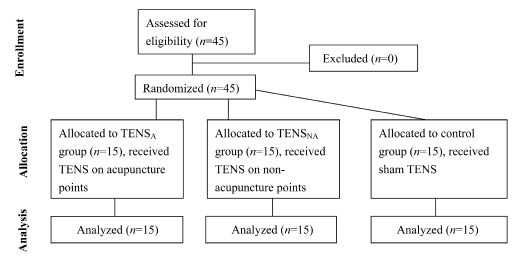
Fig. 1. Consort flow diagram. TENSA group: transcutaneous electrical nerve stimulation on acupuncture points; TENSNA group: TENS on non-acupuncture points.
During the experiment, the room temperature was controlled. The subjects remained seated comfortably with their right forearm placed in a pronated position on a table. The skin over the right forearm and hand was prepared with alcohol prep and abrasive tape (3M Red Dot Trace Prep, Ontario, Canada) to remove surface lipids and to enhance electrical conductivity (4). Then, the electrodes for TENS stimulation and for the recording of the SNAPs of the SRN were attached.
TENS procedures
A TENS unit (120, ITO Company Ltd, Tokyo, Japan) was used for stimulation. In the 2 TENS groups, an asymmetrical biphasic rectangular pulse was delivered at a pulse frequency of 4 Hz and a pulse duration of 200 μs, and the intensity was described as strong but comfortable by subjects, with muscle contraction in wrist extension observed. Intensity was adjusted periodically to maintain a similar sensory stimulation level throughout the stimulation period. The total stimulation time lasted for 30 min delivered in 2 blocks of 15 min, with another 30 min as the post-stimulation monitoring period. For the control group, all of the parameters remained the same except that there was no active TENS stimulation (Table I). All subjects were told that they might or might not experience anything during the intervention period.
| Table I. Experimental groups | ||
| Group | Electrode placement | Parameters |
| TENSA, (n = 15) | Acupuncture point LI 11 (Quchi) of right arm | 4 Hz, 200 μs |
| TENSNA, (n = 15) | Non-acupuncture point along the right superficial radial nerve | 4 Hz, 200 μs |
| Control, (n = 15) | Lateral right forearm | No stimulation |
| TENSA group: transcutaneous electrical nerve stimulation on acupuncture points; TENSNA group: TENS on non-acupuncture points. | ||
For the group receiving TENS on acupuncture points (TENSA group), silicone rubber electrodes (3.5 × 5 cm) with hydrogel pads were placed over acupuncture point LI 11 (Quchi) of the right elbow. This point was first located by palpating at the end of the transverse cubital crease when the elbow was flexed at 90° (13). The exact location of the point was then confirmed by using a 972A digital multimeter (Hewlett-Packard Company, CA, USA) where the skin resistance was lower than the surrounding skin area (14–15). The cathode was placed directly on this point, with the anode 1 cm distal of it. For the group receiving TENS on non-acupuncture points (TENSNA group), electrodes with the same sizes were placed over non-acupuncture point on the lateral border of the right forearm in the distribution of SRN within C6 dermatome (16). The electrodes were placed 1 cm apart with the cathode located at the proximal end. Extra attention was made to avoid any overlapping of electrodes placements of TENSNA group in the nearby acupuncture points. In the control group, electrodes were placed over the right forearm of the subjects, as did the TENSA group.
Recording of sensory nerve action potentials and superficial radial nerves
SNAPs in the SRN of the right forearm were captured for analysis. Two disk electrodes were used for recording. The active recording electrode was placed over the main portion of the nerve as it crosses the tendon of the extensor pollicis longus, medial to the anatomical snuff box. The reference recording electrode was placed at 3 cm distal over the belly of the first dorsal interosseous muscle. A stimulation electrode, consisted of 2 disc electrodes embedded in plastic with a constant inter-electrode distance of 2.3 cm, was used to identify the course of the SRN and was afterwards attached to the forearm. The cathode was placed 10 cm proximal to the active recording electrode. The ground electrode was strapped around the subject’s right wrist. Fig. 2 illustrated the experimental set-up for this procedure. This positioning of electrodes allows anti-dromic stimulation, which is clinically easier to use (17). It can produce high-amplitude responses more consistently than orthodromic stimulation, and can minimize the possibility of median nerve sensory potential contamination (4, 5). All of the electrodes were connected to the Neuropack Σ evoked potential measuring system (Nihon Kohden Corporation, Tokyo, Japan). Stimulation consisting of 100 μs pulses was delivered at the supramaximal level, which was the intensity with the maximal response amplitude. The stimulus comprised 16 pulses delivered at 1 Hz, with the responses averaged and stored.
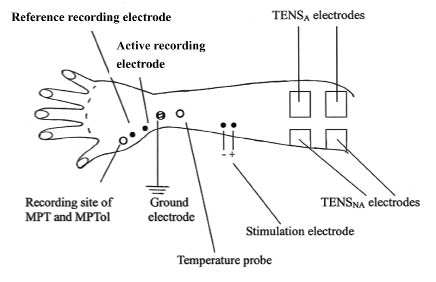
Fig. 2. Experimental set-up: the electrode of transcutaneous electrical nerve stimulation of acupuncture points (TENSA) group was placed over acupuncture point LI11 (Quchi), and the electrode of TENS on non-acupuncture points (TENSNA) group was placed over the radial side of the right forearm in the distribution of superficial radial nerve and excluding the nearby acupuncture points. MPT: mechanical pain threshold; MPTol: mechanical pain tolerance.
The subjects were allowed to rest and acclimatize to room temperature for approximately 10 min before the first recording. A C9001 thermometer probe (Comark, Sheffield, UK) was positioned on the dorsal aspect of the right forearm midway between the ground electrode and stimulation electrode to record skin temperature (Fig. 2). SNAP recordings were taken within 1-min intervals, and 3 consistent measurements were obtained, with no more than ± 0.02 ms variation in NPLs. NPLs were taken at the point of maximum negative peak amplitude from the stimulus artefact. The recording of action potentials in the SRN was performed at 10 and 0 min before TENS, 15 and 30 min in the stimulation, and a post-stimulation recording was then made at 45 and 60 min. The recordings at time 10 and 0 min before TENS were averaged, and this value was regarded as the baseline of time zero. All of the recordings were stored for subsequent analyses.
Recording of mechanical pain threshold and mechanical pain tolerance
A pressure algometer (Pain Diagnostics & Treatment Inc, Italy) was used to measure MPT and MPTol. The measurement point was standardized at 3.5 cm distal from the proximal edge of the anatomical snuffbox over the first dorsal web space (Fig. 2), which was an area innervated by the SRN (3–5). Once the initial contact was made, manual force was applied perpendicularly onto the skin through the circular probe head (1 cm2 surface) of the algometer. The force was increased at a steady rate until the MPT and MPTol was registered. MPT was determined by the subject’s verbal report when a pain sensation was elicited. After MPT was reached, manual pressure was continued to apply through the algometer until the intolerable pain sensation was reported by the subject, and it was recorded as the MPTol. Two trials were taken at various time intervals including 10 min before TENS stimulation, and at 0, 15, 30, 45 and 60 min. The recordings at time 10 and 0 min before TENS were averaged, and this value was considered as the baseline of time zero. All of the subjects were given a demonstration of measurements on the left hand prior to the actual recording.
Data analysis
Baseline measurements of NPL, MPT and MPTol obtained in various groups were compared using a one-way analysis of variance (ANOVA) to test for any group differences. All measurements obtained at various time intervals in groups were analysed by repeated measures ANOVA; and followed by post hoc tests whenever appropriate to assess the differences over time and between groups. On the contrary, any outcome measure that showed a significant difference in the baseline measurement would be treated as a covariate, and the readings would be analysed by repeated measures analysis of covariance (ANCOVA). Statistical significance was set at 0.05. All of the data were analysed using the Statistical Package for Social Sciences (SPSS, version 16.0, Chicago, USA) for Windows.
RESULTS
Room temperature was well controlled at approximately 25°C throughout the experiments, and the skin temperature of the subjects was maintained at approximately 30°C (standard deviation (SD) 1). There was no significant difference found between the 3 groups (p = 0.486), or within the groups over time (p = 0.131). Thus it was supposed that the skin temperature was relatively stable during the experimental period and should not influence the results of the NPL measurement.
Negative peak latency
Fig. 3 shows the means (SD) of NPLs over time for all groups. An increase in NPL occurred in the TENSNA group. The NPL increased slowly from the baseline of 2.20 ms (SD 0.24) and reached a maximum of 2.29 ms (SD 0.32) by the end of the experiment. This corresponded to a slower nerve conduction velocity. In the TENSA group, a decrease was first seen in NPL after 15 min of TENS application, but a gradual increase to a maximum of 2.19 ms (SD 0.21) at the 45-min point was then observed, followed by a slight decrease. There was an overall increase in NPL of 1.4% in this group, although the change was smaller than in the TENSNA group. The NPL values of both the TENSA and TENSNA groups showed a tendency to increase. While the NPL in the control group decreased from 2.25 ms (SD 0.23) to 2.21 ms (SD 0.25) at the 15-min point, there were little changes for the rest of the experimental period. A decrease in NPLs below the baseline indicated an increase in nerve conduction velocity. There was no interaction of “group” and “time” (p = 0.148). A significant difference over time was found within the 2 TENS groups (p = 0.015), indicating an increase in NPLs during and after TENS stimulation. However, there was no significant difference among all the groups (p = 0.638).
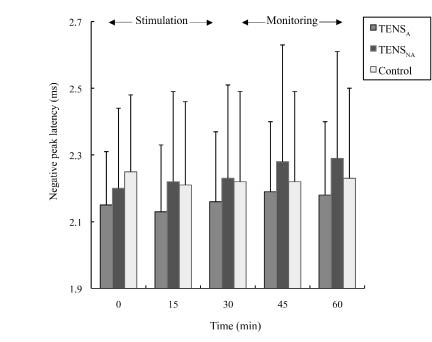
Fig. 3. Mean negative peak latency for all groups over time. Errors bars correspond to +1 standard deviation. TENSA group: transcutaneous electrical nerve stimulation on acupuncture points; TENSNA group: TENS on non-acupuncture points.
Mechanical pain threshold
Mean MPTs (SD) at each time-point for each experimental group are presented in Fig. 4. MPT values above the baseline indicate a hypoalgesic effect, and those below baseline indicate hyperalgesia. There was a rapid increase in MPT values after 15 min of TENS stimulation. All of the MPT values were maintained well above the baseline values at each time-point of measurement. In the TENSA group, the MPT increased from the baseline of 3.82 kg/cm2 (SD 1.14) to 3.96 kg/cm2 (SD 1.38) by the end of the 30-minute post-stimulation period. In the TENSNA group, there was an increment of 0.41 kg/cm2 from the baseline values to the end of the 30-min post-stimulation. In the control group, an increase was also observed in the MPT. There was no interaction between “time” and “group” (p = 0.628). A significant hypoalgesic effect was observed in the groups over time (p = 0.002). However, there was no significant difference between the groups (p = 0.711).
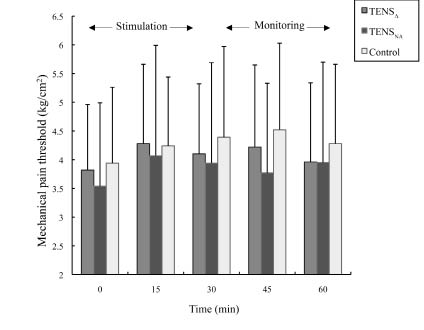
Fig. 4. Mean mechanical pain threshold for all groups over time. Errors bars correspond to +1 standard deviation. TENSA group: transcutaneous electrical nerve stimulation on acupuncture points; TENSNA group: TENS on non-acupuncture points.
Mechanical pain tolerance
Fig. 5 presents the summary of MPTol means (SD) over time for the groups. In the TENSA group, the MPTol values increased from baseline to a maximum value of 7.69 kg/cm2 (SD 1.50) after 15 min of TENS stimulation; it then dropped gradually for the rest of the period. The MPTols in the TENSNA group had lower values than the other groups; the reading decreased from 6.45 kg/cm2 (SD 2.33) to 6.31 kg/cm2 (SD 2.24) in 60 min. In contrast, the readings of the control group seemed to fluctuate over time. It decreased for 15 min after stimulation, then increased to the peak value of 7.44 kg/cm2 (SD 1.96) at the 30-min point and dropped below the baseline afterwards. All groups demonstrated a distinct pattern of MPTol values over time and there was no interaction between “time” and “group” (p = 0.743). There was no statistically significant difference recorded in MPTol over time (p = 0.427) or between groups (p = 0.243).
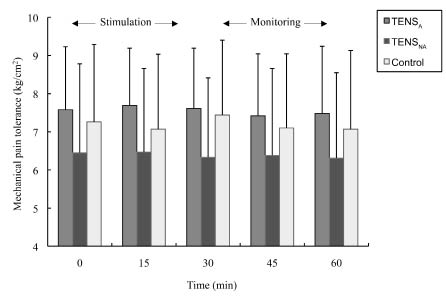
Fig. 5. Mean mechanical pain tolerance for all groups over time. Errors bars correspond to +1 standard deviation. TENSA group: transcutaneous electrical nerve stimulation on acupuncture points; TENSNA group: TENS on non-acupuncture points.
DISCUSSION
Our findings on NPLs showed no significant between-groups difference, but significant change within the groups over time (p = 0.015). The NPLs increased during and after TENS stimulation, which had an impact on peripheral neurophysiological changes. The increase in NPL in both the TENSA and TENSNA groups indicated a decrease in the nerve conduction velocity. The SRN mean conduction velocity also slowed down upon application of active TENS. In contrast, the control group showed only a negligible decrease in NPL over time.
These findings are consistent with previous studies conducted by Walsh et al. (4, 5), who reported an increase in NPL of SRN after both high-frequency (110 Hz) and low-frequency (4 Hz) TENS stimulation over the course of SRN. Acupuncture-like TENS produces a similar activation of fibre types (II and III) to that obtained with acupuncture, with a more sustaining hypoalgesic effect (3, 18). Since the present study involved the application of TENS over acupuncture points, acupuncture-like TENS with a pulse frequency of 4 Hz, pulse duration of 200 μs and high intensity was used. Thus the peripheral neurophysiological effects may at least partly explain the TENS-mediated hypoalgesia. The shift in NPL could be taken as an indication that the A fibre afferents are slowing down to some extent, which induced a peripheral blockade or an alteration in the excitability properties of the nerve (4, 19). It is assumed that when the peripheral conduction slows down, the amount of nociceptive input would be reduced accordingly to produce hypoalgesia (1).
Temperature change over the skin is one of the non-pathological influential factors in nerve conduction studies (20, 21). The change in peripheral neurophysiological responses observed in the present study was not affected, because the skin temperature was well controlled throughout the study period.
In clinical practice, TENS electrodes are usually placed on the painful site or over spinal segments related to the site of pain. The current study is the first to compare the peripheral neurophysiological effects of TENS on acupuncture points with that along the peripheral nerve. The results showed no significant difference between groups, indicating that TENS over acupuncture points offers no additional hypoalgesic effects vs TENS over the skin area supplied by the peripheral nerve. However, we observed an increase in the NPL of the TENSA group over time. This effect may be due to the specific characteristics that occur at acupuncture points. There are at least 10 structures found in the vicinity of the points, including large peripheral nerves, cutaneous nerves, blood vessels and motor points. The major correlation between these points seems to be the presence of nerve, whether they are large nerve bundles or nerve endings (18). The acupuncture points are the loci of types II and III afferent nerve fibres. The stimulation of types II and III fibres can produce a sensation similar to that of acupuncture and gives rise to analgesia (18). Stimulation of acupuncture points by TENS can activate receptors in the peripheral neural tissue and create a concomitant response in the peripheral neurophysiological aspect (22). It also directly activates the large-diameter fibres that carry non-painful information and prevent the transmission of noxious signals (23).
The present study did not show that the choice of electrode placements of TENS produces significant sensory changes in the mechanical pain outcomes (i.e. MPT and MPTol) between groups, but MPT increased significantly within-group over time. Hypoalgesia was found in both active TENS groups. Chesterton and co-workers (3) demonstrated that low-frequency TENS applied over acupuncture points was more effective in producing a rapid onset and long-lasting hypoalgesia than on other sites; they showed that the MPT was significantly elevated in healthy human by segmental TENS, but could only be achieved at extrasegmental sites when TENS was given at high intensity. Attele et al. (24) also supported the efficacy of transcutaneous electrical acupuncture-point stimulation analgesia. In contrast, some studies showed that the application of TENS over peripheral nerve points could induce significant hypoalgesic effects. TENS elevates ipsilateral somatosensory thresholds within the distribution of stimulated median nerve in healthy human participants, which suggests a central segmental involvement (25). Another study on healthy subjects showed that TENS applied on superficial radial nerve distribution significantly increased the heat pain threshold both during and after stimulation for up to 10 min (26). The post-stimulation hypoalgesic effect persisted for at least 30 min. The results in the present study are in agreement with their findings.
This hypoalgesic effect of TENS application may suggest some form of systemic response in line with the descending pain suppression system that is mediated by endogenous opioid (3, 12, 24). Low-frequency TENS stimulation induces the selective release of endorphins in the central nervous system (3), and electroacupuncture triggers the release of peripheral opioids at the inflammatory site (27). This may account for the increase in MPTs in both active TENS groups in this study. Nevertheless, the specific action mechanisms of TENS are still not completely understood.
We did not anticipate an increase in MPT over time in the control group since the subjects did not receive any electrical stimulation. With reference to the demographic data in different groups, there were 9 male subjects in the control groups and only 6 in both TENS groups. More male subjects were found in the control group, which may partly explain for such a between-group difference. Previous studies also reported the gender differences in the pressure pain threshold and tolerance, with females tending to exhibit lower values than males (28, 29). However, the reason behind the increasing trend in the control group remains unclear.
Despite the application of TENS, we observed a trend of hyperalgesia developed over time, even though the between-group difference did not reach significance. The observed hyperalgesia could be due to the sensitization of nerve endings by the repeated testing of pain tolerance. This is contradictory to a previous study that reported an increase in tolerance to ice pain after TENS (30). We did not find that TENS influenced MPTol, probably because there are great individual variations in perceived MPTol. Therefore, most of the available studies reported only the effects of TENS on pain thresholds, but seldom on tolerance to pain.
In fact, the variability in experimental pain perception results from factors including gender, psychosocial factors, biological and experimental variables (28, 31, 32). Psychosocial factors include familial influence, expectations, emotions, and an individual’s unique learning history (28, 31). Biological variables include hormonal status and cardiovascular reactivity (28, 31). Experimental variables include the type of pain induction method, environmental setting, the experimenter’s appearance, the subject’s interpretation of the instructions, or familiarity with the test and possible personal biases (31, 32). Anxiety and fear have also been reported to reduce the pain threshold (28). Indeed, previous study also suggested that pain tolerance in particular is known to be influenced more by personality, cultural background, and degree of motivation and co-operation (29).
It is worth bearing in mind that the physiological responses to electrical stimulation in an experimental model of pain may not be directly comparable to those of patients with pain in clinical situations. Thus, future studies should be conducted to evaluate the effects of different choices of electrode placement in TENS in various clinical pain conditions.
In conclusion, the application of a single session of TENS over acupuncture points and peripheral nerve points was equally effective in achieving hypoalgesic effects in the modulation of experimental pain among healthy young subjects.
REFERENCES
